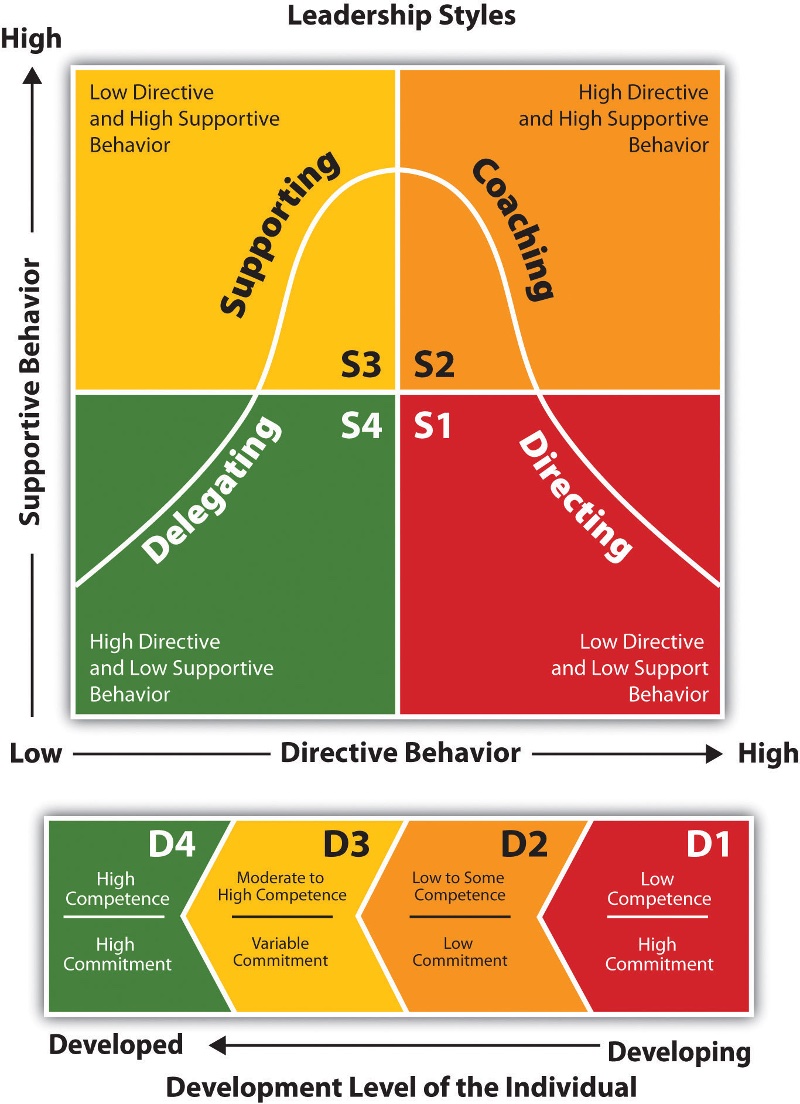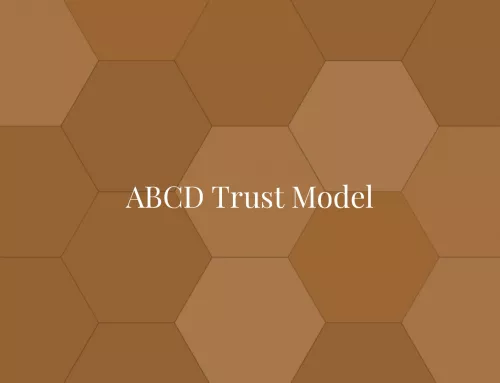Paul Hersey and Kenneth Blanchard came up with a theory called Hersey and Blanchard Situational Leadership Theory as a response to behavioral leadership approaches like Blake and Mouton’s Managerial Grid. This theory posits that the circumstances in which leaders find themselves have an impact on the type of leadership that is most effective. They argue that certain contextual factors determine a leader’s capacity to lead. Leaders will be able to influence their surroundings and followers much more successfully if they comprehend, acknowledge, and adapt to these factors than if they ignore them. More specifically, a significant portion of Hersey and Blanchard’s research was devoted to the characteristics of followers and their role in determining appropriate leadership behaviors. They discovered that as followers’ ability (Task Readiness) and willingness (Psychological Readiness) to perform the required task changed, leaders would need to adjust their leadership style. Because followers’ abilities and willingness can change over time, a leader’s relationship with them is likely to change over time. To better deal with these various stages of followers, Hersey and Blanchard introduced four leadership styles:
- Telling
- Selling
- Participating, and
- Delegating
Differences In Nomenclature
Though Hersey and Blanchard collaborated for a number of years to support the idea that leadership styles should be situational, they decided in 1977 to split up to concentrate on their own goals. As a result, the Hersey and Blanchard Situational Leadership Model, formerly known as The Life Cycle Theory of Leadership, has evolved into two models that are slightly different. The Situational Leadership II Model, or SLII Model, was Blanchard’s decision to use for his version of the model. Semantics accounts for the majority of the distinctions: Blanchard preferred to use the term Development (D) where Hersey used the phrase Readiness (R). Furthermore, Blanchard used the terms Directing, Coaching, and Supporting in place of Hersey’s usage of Telling, Selling and Participating.
Follower’s Ability
Blanchard and Hersey’s Follower Ability model is a classification system that categorizes followers based on their readiness along 2-dimensions:
- Task Readiness
- Psychological Readiness
Task Readiness
The capacity of a follower or subordinate to carry out the tasks that have been assigned to them is known as their Task Readiness. Their ability, knowledge, and skills will have an impact on how they complete a task, regardless of how a leader directs them. Since followers are likely to grow in their abilities over time, Blanchard preferred to use the term development rather than readiness. Furthermore, Blanchard used the term competence, which means: skills, knowledge, and capabilities) rather than Hersey’s abilities.
Psychological Readiness
The degree to which a follower or subordinate is willing to accept responsibility for their actions is known as their Psychological Readiness. This includes things like their drive, energy, and belief in their own abilities. Blanchard used the term commitment to describe this. confidence and drive) rather than Hersey’s Willingness.

Situational Leadership Styles
Types Of Followers
Based on the Hersey-Blanchard model, the four groups of followers are:
- Unable and Willing (D1)
- Unable and Unwilling (D2)
- Able and Unwilling (D3)
- Able and Willing (D4)
Unable and Willing (D1)
D1 followers are also known as the dependent follower. The followers demonstrate high commitment, but low competence. D1 followers are like D2 followers – they are unable to complete a task, but unlike the D2 followers, they are willing and motivated to attempt the task.
These followers are highly dependent on the leader for direction, guidance, and support. They may lack the skills, abilities, and confidence to complete the task on their own, and they may be hesitant to take initiative. They need a lot of support and reassurance from the leader and may struggle to take on more responsibility or make decisions on their own. They may also have a lack of motivation to take on new tasks or challenges.
New employees who want to impress their manager, but lack the work experience necessary to be productive right away frequently exhibit this follower style. Blanchard decided to name this follower style D1 because, in his view, this represents the first stage of a follower’s growth. As followers gain experience, they reach development level 2 (D2) and acquire some competence; however, their commitment decreases as the task may be more complex than the follower initially anticipated.
Unable and Unwilling (D2)
D2 followers are also known as the compliant follower. The follower demonstrates a lack of commitment and competence. These followers are willing to do what the leader asks of them, but they may lack the motivation and drive to go above and beyond what is required.
A follower with a status of D2 is unable to complete the required task because they lack the skills necessary for success. Furthremore, they may not take initiative or think creatively about how to do so. They tend to follow the rules and procedures, rather than challenging them. They also may lack the self-confidence to take on new challenges or to propose new ideas. They tend to be more passive and content with the status quo, not actively seeking more autonomy or opportunities to advance.
Blanchard gave this follower style the designation D2 rather than D1 because he views this follower style as the second stage of the follower’s evolutionary development.
Able and Unwilling (D3)
The followers demonstrate high competence and low commitment. D3 followers, also known as the hesitant follower. D3 followers are likely to perform their tasks well, since they have developed the necessary skill set. However, they may lack motivation or confidence resulting in a lack of commitment to the task at hand.
In Blanchard’s vocabulary of the D3 follower style, commitment is variable as it starts off as low, but gradually grows bigger due to more self-esteem and confidence.
With the right support and encouragement from the leader, D3 followers can gradually increase their commitment and eventually reach the D4 follower style.
Able and Willing (D4)
The followers demonstrate high competence and high commitment. D4 followers are also known as “the self-reliant follower.” These followers are independent, self-motivated, and take initiative. They have a high level of commitment to their tasks and are willing to put in the extra effort to achieve their goals. They have a high level of skill and ability and have developed a good sense of self-confidence. They tend to be proactive in seeking out new challenges and opportunities, and are willing to take risks and make decisions on their own. They are also open to feedback and willing to learn from their mistakes. They are less dependent on the leader for direction and are more likely to take the lead in the team. They tend to be self-directed and have a strong sense of ownership for the task at hand. In this stage, both competence and commitment are considered to be high in terms of Blanchard’s version of the Situational Leadership Model.
Leader’s Behaviours
Hersey and Blanchard assert that every circumstance and person is unique, necessitating a change in leadership or management style for success. Particularly as a leader, you must approach each team, individual, and skill differently depending on their level of development. A skill can refer to any technical or non-technical skill, a required level of competence, or anything else.
Under the Hersey-Blanchard model, a leader must adapt their leadership methods depending on the ability and willingness of their followers. For example, a follower with a D2 development level should be led differently than a follower with a D4. Therefore, the Hersey-Blanchard model outlines four distinct leadership styles, each corresponding to a specific level of employee development.
Hershey and Blanchard prescribe two different leadership styles to lead and motivate followers:
- Directive
- Supportive
Directive Behaviour
Leaders should adjust their leadership style so that it meets the needs of their subordinates based on these different follower styles. By striking the right balance between directive and supportive behavior, they can accomplish this. The concern for production dimension of Blake and Mouton’s Managerial Grid reflects a leader’s directive behavior, which will range from high to low. This indicates how much of an emphasis a leader places on the need to complete the task at hand. The readiness or development level of followers will determine the appropriate level of directive behavior that leaders must select.
Supportive Behaviour
A leader’s supportive behaviour reflects the concern for people dimension of Blake and Mouton’s Managerial Grid. This means to what extent a leader puts emphasis on building and maintaining a good relationship with subordinates by paying attention to the security, well-being and personal needs of the employees. The appropriate level of this relationship-focused approach is just like the directive behaviour determined by the readiness or development level of followers.
Leader’s Actions
The four leadership behaviour actions are:
- Directing
- Coaching
- Supporting, and
- Delegating
Directing (Telling) (S1)
The S1 leadership style in the Hersey and Blanchard Situational Leadership Model puts a high emphasis on directive behaviour and a low emphasis on supportive behaviour. A leader’s primary concern lays with the task delivery and less with the personal needs of the subordinates. Typical behaviour for a S1 leadership style, according to Hersey, is offering step-by-step instructions, clear explanation of the consequences of non-performance and close supervision. In such a situation, it is important that the task is clearly defined and the stages of the process are easy to follow. This is important because the leader believes that the follower (R1) either does not know what to do or is unwilling and requires therefore a certain degree of coercive power. Blanchard, on the other hand, believes that this style should be used for D1 followers who are highly ‘Enthousiastic Beginners’. They already have the motivation to do the tasks required, which lowers the need for supportive behaviour. But they still lack the competence, which increases their need for directive behaviour.
Coaching (Selling) (S2)
The next leadership style is the high directive and high supportive S2 leadership style. Hersey argued that this style is needed for R2 followers who are willing, but not able to perform a task. The leader’s style should therefore be concerned with increasing the confidence and skills of followers so that they can ultimately take on more responsibility for their actions. Blanchard, however, believes this style is necessary for D2 followers, who used to be highly enthousiastic in the beginning but who lost confidence because their competences are failing them. These ‘Disillusioned Learners’ therefore need a leader with a higher concern for supportive behaviour that helps them gain confidence and become motivated again.
Supporting (Participating) (S3)
The S3 leadership style applies to both R3 and D3 followers. This style (still) shows high supportive behaviours, but low directive behaviours. This may involve listening, praise and a high level of interaction between leader and follower. In addition, the leader puts a high level of trust in the follower to achieve the day-to-day tasks as the follower’s competence has also grown over time. The leader will therefore only encourage and offer feedback when needed to motivate and develop the subordinate, but not as a comment on the task performance. This is because the leader believes that the follower is capable enough of achieving the required tasks largely independently.
Delegating (S4)
The final leadership style assumes a low supportive and a low directive behaviour and applies to R4 and D4 followers. This is very much a ‘hands-off approach’ as the subordinate is perfectly able and willing to perform the tasks independently and with great responsibility. The leader can further encourage autonomy, while keeping an eye on not overloading the follower with responsibility and not withdrawing completely from the follower’s proximity. For these type of followers it is thus important as a leader to keep observing and monitoring them (albeit to a far lesser degree), in order to provide the necessary support if needed.




